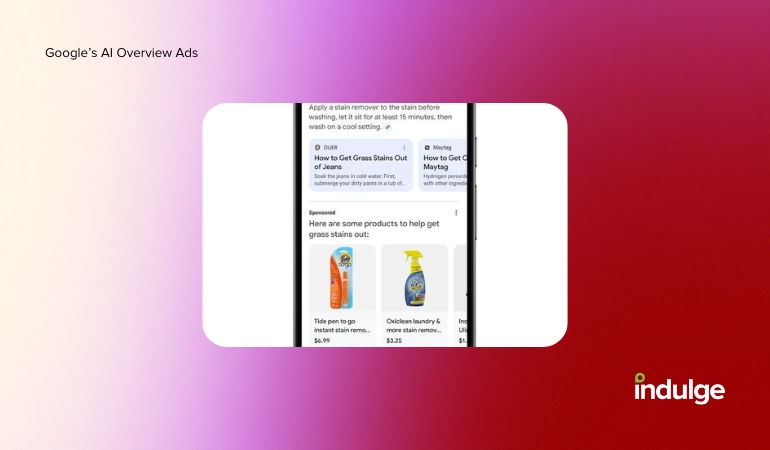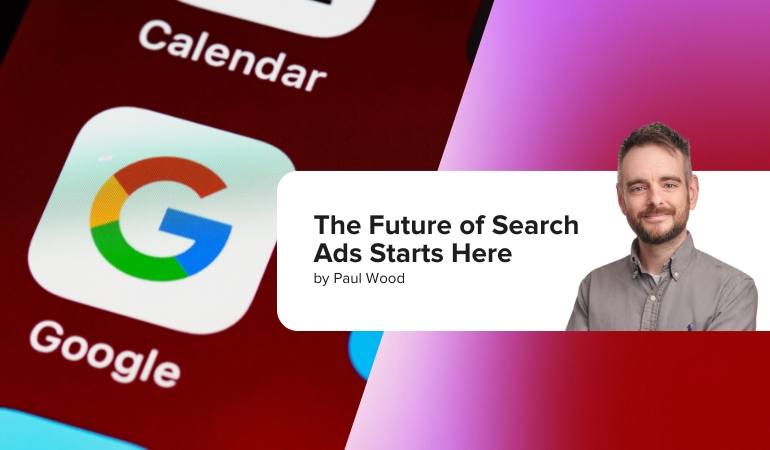October 3rd was a busy day for AI search announcements coming from Google with two potentially significant milestones reached.
AI Overview Ads
For those expecting the next big thing in advertising, sit back down, because this is what it looks like. It’s a row of advertising results underneath a ‘sponsored’ heading.
Google sells advertising space. It’s what turned a search engine into the biggest media company in the world.
Ever since ChatGPT captured the attention of the web, the question on many lips was ‘how will Google make advertising revenue when AI engines eventually take over from search?’
Today, we have our first look at an answer.
As a quick primer; AI Overview is the name of the search product Google launched in May 2024. In simple terms, it’s a generative AI window that appears at the top of the Google search results page for some (not all) searches.
When a user search lends itself well to an AI-generated answer, Google’s bot will compile the research and references it needs and then string together some words to provide an answer.
As of 3rd October, Google has started rolling out ads within its AI Overview results, starting with US-based mobile users.
For those expecting the next big thing in advertising, sit back down, because this is what it looks like.

It’s a row of advertising results underneath a ‘sponsored’ heading.
Presumably, Google is keeping the fireworks in the box for the moment.
I’m going to predict that, for now, this isn’t going to turn digital advertising on its head, but there are certainly some things all Google Ads users should know.
You’re all invited
Don’t want to show your ads in the AI Overview section? Tough, because you’re taking part anyway.
That’s right, if you run ads using Google Ads, you're eligible for a place here.
I’m being salty, I know. In reality, this is good in one sense. Google says there’s no additional action required. If you run search ads or shopping ads, you will be able to show up in AI Overviews when it’s deemed appropriate.
As of now, you can’t opt out. If Google’s systems think you're a good fit, it will show your ads.
Don’t want to show your ads in the AI Overview section? Tough, because you’re taking part anyway.
Reporting
Google can be a bit ‘cloak and dagger’ at times. I once wrote an article about how the Google Ads system is infuriatingly opaque at times.
It’s good to know that they are staying on brand because AI Overview ad performance won’t appear in any reports at the moment.
It means that when running ads, advertisers won’t know whether impressions occur in classic Google Search or via AI Overviews.
To be fair to Google, this needn’t be a major challenge for advertisers, you retain access to information such as:
Search Term Performance - this tells you what search terms have triggered your ads (AI Overviews included).
Impressions, Clicks, CTR, and Cost - you’ll still be able to tell when your vital signs are healthy or flagging. If an influx of AI Overview ads tanks performance, you’ll soon know and be able to refine using Search Term reporting.
Despite this, I think many of us would still like to see how AI Overviews perform in comparison to Search Ads; imagine seeing the relative click-through rates and imagine what that could also tell us about how organic AI Overview results are likely to influence website traffic as well.
I expect that’s probably the reason Google is reluctant to share this data.
An opportunity to advertise based on symptoms
AI Overview Ads do present an exciting prospect. Google Ads has historically excelled as a demand-fulfilment platform.
If a person searches for ‘red shoes’, you can show them an advert for some red shoes.
It has been trickier to use Google Search as a way to generate demand.
I believe that AI Overviews encourage a different type of interaction between users and Google. It rewards exploratory search queries.
Instead of searching just for a solution, or well-defined challenge, users will learn to use Google to search for what we’ll call ‘symptoms’.
A symptom could be, ‘Windows error code XYZ123’.
An AI Overview will be able to initiate an exploration of the symptom and (with this recent announcement), match the searcher with relevant ads (ie. a qualified IT technician, a self-help guide, a piece of software).
In the past, an advertiser would have needed to successfully predict symptom-type searches, but I think we’re going to witness a growth in these types of searches with little need for advertisers to manually target ads to them. Google’s system (if it works well) will do the matchmaking for you.
AI-organised Results
AI Overviews are now set to be joined by something called AI-organised results.
This is another feature that is being rolled out in the US on mobile devices now. It will start life on search result pages relating to recipes and meal ideas.
AI-organised search results are a potentially exciting prospect; they will take a set of search results and will organise them underneath AI-generated headings and within distinct sections.
Here’s a link to a short clip Google shared demonstrating the new feature in action.
It’s been years since Google’s search results were a list of ten blue links. Many searches will contain image rows, video sections, maps, reviews, and other pieces of information.
AI-organised search results could conceivably be a much more useful version of the Google we know today.
The example video shared by Google shows the user selecting ingredients they have available and then refining the search results based on that. I can imagine that type of ‘refine search’ interface working really well in many applications.
What should you do?
These new features, whilst reserved for the US market right now will roll out to other markets soon.
For advertisers, I don’t think there’s any action to take immediately beyond ensuring you maintain a solid performance dashboard.
Having a dashboard that flags when something is going well, or wrong, is important now and will remain important when AI Overview Ads come your way.
You won’t be able to directly control the AI Overview Ads, but with any change in Google’s system, it will pay to monitor the global impact on your account.
As for AI-organised search results, this makes the thankless task of tracking keyword rankings even more problematic.
Increasingly, we’re relying on metrics such as impressions, clicks, and visibility/search market share to assess performance. That’s going to be the way the industry needs to head, I believe.





